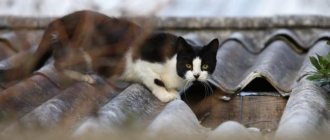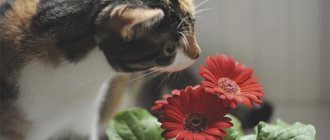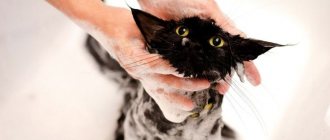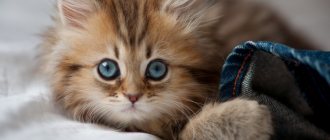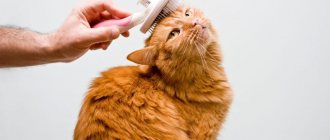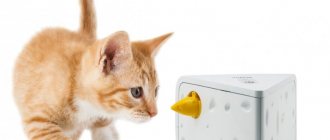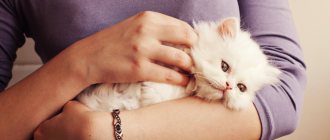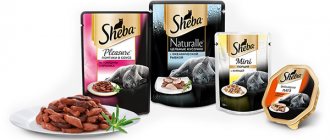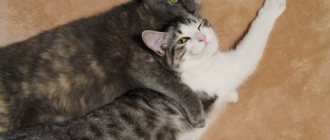Cats, depending on their breed, have different temperaments. Some are calm and slow. These are passive breeds, such as Persian, Ragdoll, Selkirk Rex, Exotic Shorthair, etc. They are reluctant to play and move little. Their complete opposite is active breeds, such as Siamese, Abyssinian, Balinese, Kurilian Bobtail, etc. They are very energetic, have a well-developed hunting instinct and need constant movement. A running wheel will help such pets.
How to make a trainer yourself
There are many photos and videos with different DIY cat wheel options. This article will provide several step-by-step instructions.
Method one
This option will be quite difficult for craftsmen who have never cut into a bearing or installed rollers. More experienced craftsmen will be able to figure it out without difficulty, since photos are posted as tips.
To work you will need:
- plywood;
- Miter saw;
- rail;
- rollers;
- pencil;
- Dremel;
- centimeter;
- bearing;
- beam;
- rope;
- fasteners;
- carpet;
- drill;
- glue;
- sander;
- bolt with nut;
- pipes;
- knife;
- double sided tape.
The sequence of actions can be divided into seven stages:
Creating a foundation. Two circles of plywood with a radius of 46 cm are cut out, which will be the base of the wheel. They are connected to each other using bars.
Manufacturing of slats. The slats are glued around the end part. For greater strength they are secured with straps.
Installation on rollers. Two semicircular stands are equipped with two rollers on both sides, on which the running wheel will subsequently be installed. It is due to them that the simulator will rotate.
Wall installation. Another circle is cut out of plywood and glued to the support. In the future, a bearing will be attached to it.
Axle placement. Since the running wheel rotates on an axis consisting of a bolt with a bushing, to install it it is necessary to strengthen the insertion point. To do this, a plywood square is glued to the back side of the wall, and a gear is placed in front. A hole is drilled in the center.
Making a stand. It is made from a support and bars made in the form of a rack. Two boards are fixed on it, into which bearings are installed.
Gluing the track. A strip of carpet is cut along the width of the wheel. It should be glued with double-sided tape.
Method two
This option requires the presence of a welding machine, and the manufacturing algorithm is a little simpler than the previous one. To make a running wheel for cats with your own hands according to the instructions you will need:
- steel profile;
- plywood;
- wooden barrel;
- boards;
- bearings;
- wire;
- fasteners and wrench;
- welding machine;
- dye;
- drill;
- jigsaw;
- roulette.
The sequence of actions consists of three stages:
- Creating a frame on which the wheel will be attached. To do this, you need to weld a rectangular frame from a steel profile. Immediately on the long side, retreating 10 cm from the edge, weld the crossbar. Also attach two hinge posts to it through welding at an angle of 30-45 degrees.
- Making the running wheel itself. Cut off part of the barrel. To prevent the boards from falling apart, they need to be bolted together. Cut out the back wall for the drum from plywood. The circumference should be slightly smaller than the inner diameter of the narrow part of the barrel.
- Assembly of the structure. Attach the drum to the hinge so that it can rotate freely. This should be done so that the wheel rotates only forward and backward, and does not sway left and right.
Regardless of whether the running wheel for cats is made with your own hands or purchased in a specialized store, it must be securely fastened
This is important so that when the cat jumps, it doesn’t knock over the structure and injure itself.
If the running wheel is made according to all recommendations and securely fixed in the house, you can be sure that it will become one of your mustachioed pet’s favorite places to spend active time.
Useful video on creating a cat wheel from cardboard:
Many pets are accustomed to leading an active lifestyle. At home, a loving owner needs to monitor the physical health of his pet. As it turns out, it's not just hamsters or chinchillas that need a running wheel. Recently, such a simulator has found its use among cat owners.
DIY running wheel for cats
The fastest cats
What helps the fastest cats run
Among purebred cats, the Egyptian Mau is considered the record holder for speed. He was lucky with the structure of his hind legs, which have leathery folds at the base. Due to them, while running, the step reserve and amplitude of movements increase, and therefore the speed increases.
The normal speed of cats (on average) is 13.5-13.8 km/h. If a cat moves at a leisurely trot, then it will barely overtake a walking person, and its speed will be about 8 km/h. Whereas the maximum speed of cats is 50 km/h.
Who would like a cat exercise machine - a running wheel?
Cats, like people, differ in character and temperament: some can spend the whole day on the couch, others need constant movement.
Passive cats play reluctantly, sleep 20–22 hours a day, are calm and slow. Active ones clearly demonstrate the hunting instinct, restlessly rush around the entire apartment, play a lot and noisily, splashing out their energy. In this they differ little from their wild relatives: in nature, such cats can cover a distance of more than 10 km at night in search of food. If every day your pet wakes you up in the morning with noisy running around, joyfully pounces on every new toy, jumps on furniture, then this definitely means that you are the happy owner of an active breed of cat. A running wheel will come in handy in a home where representatives of such active breeds as Siamese, Bengal, Abyssinian, Kurilian Bobtail, Egyptian Mau, Balinese and others live.
Cat in a running wheel
City apartments are cramped for such cats, they limit their hunting territory, so tailed fidgets endlessly run around the house, jump on windows and curtains, damage furniture, causing trouble for the owner. It is especially difficult for pets if the owners do not have the opportunity to take the cat for a walk. Cats may begin to mark their territory at home by running restlessly around the rooms.
The simulator will help calm the animal and redirect attention
The treadmill wheel is very popular in Europe, and this exercise machine has recently appeared on Russian shelves.
Now it can be purchased at any pet store, which allows every owner to take care of the health of their cat, or to make it themselves.
A treadmill is similar to a human treadmill. It helps the cat lose excess weight, strengthen the cardiovascular system, muscles, and lungs.
The wheel will be useful for overweight cats and will help them get into good physical shape. Spayed and neutered cats are most susceptible to overeating. As in humans, this can lead to serious heart disease, metabolic disorders, and stress on internal organs and joints.
Together with proper nutrition, such a simulator will allow your cat to stay healthy and lose extra pounds.
The simulator can replace a scratching post. The inner covering is made in such a way that the cat can rest on it with its paws. The animal will use the running wheel when it is bored or the owner is not at home. If there are several cats in a family, then the simulator will be an excellent play complex for them.
Running on a wheel allows your cat to burn off some energy.
Who needs it?
A running wheel is a kind of exercise machine, which is primarily needed by active domestic cats. Space in apartments is quite limited and animals do not have the opportunity to express all their energy. If you prevent an active pet from playing, then over time he may become lazy and spend most of his time sleeping or at the food bowl.
Passive individuals have an increased risk of gaining excess weight, which, in turn, can lead to serious health problems. A running wheel will be an excellent alternative to free-ranging on the street for natural predators.
Among all cats, representatives of the following breeds are distinguished by activity:
- Abyssinian;
- Somali;
- Egyptian Mau;
- savannah;
- Bengal;
- oriental;
- Siamese;
- Ocicat.
However, this does not mean that only these animals will like the simulator. Any cat can be active, regardless of its breed.
How to choose?
When choosing a running wheel, first of all you need to take into account the amount of free space in the apartment that can be allocated for installing the exercise machine. You also need to consider the number of cats in the house, their height and weight. For a large number of animals or for a large pet, massive, stable, semi-closed models are best suited.
Veterinarians recommend not using wheels with a diameter of less than one meter. The width of the path should not be less than thirty centimeters. Otherwise, the animal may damage its spine while exercising on small exercise machines.
When purchasing a finished model in a store, you must carefully inspect the entire structure. A product made of low-quality materials or with poor fastenings can, at best, not last long, and at worst, cause injury to your pet.
The inner surface of the wheel should not be slippery. It is best if it is covered with carpet or felt. Exercise machines differ in appearance and can be of different colors, so you can choose the right option for any interior.
Advantages and disadvantages
Running wheels for cats have both advantages and disadvantages. Let's consider the advantages of such a simulator.
- The wheel allows you to organize leisure time for your pet. Individuals who like to run around the apartment in the mornings and nights will no longer bother tired owners and wake them up.
- The health benefits for cats are undeniable. For lazy individuals, periodic jogging allows you to maintain normal weight and not gain fat. Active pets will be able to splash out their energy at any time. Exercise also helps maintain muscle tone.
- Exercising on a treadmill not only allows you to maintain normal weight and train muscles, but also has a beneficial effect on the cardiovascular system and lungs.
- In many wheel models, the inside is lined with carpet and can serve as a scratching post for your pet.
As for the disadvantages, they are not so significant for running wheels. Let us highlight the main disadvantages of the simulator.
- Ready-made models are quite expensive . However, on the Internet you can find ready-made drawings and instructions for making such wheels, which will save money.
- Some exercise machines are quite large and are only suitable for large rooms.
- Not all cats are ready to immediately appreciate all the advantages of a running wheel. The owner sometimes has to spend a lot of time to accustom his pet to the exercise machine.
Running wheels are not suitable for all cats. And it's not always about the animal's temperament. If the cat has any injuries or illnesses, training on the simulator may not be acceptable.
Step by step instructions 2
The structure will require three pillars: one 220 cm, the second – 120 cm and the third – 80 cm. On paper, mark the location of the supports, in which the longest one should be closer to the wall. The pillars are arranged in a triangle from highest to lowest.
Transfer the markings from the stencil onto the surface of the plywood. Attach each post with four long nails, drilling holes of a smaller diameter. Secure the outside supports with corners 55x20 for the large one and 35x40 for the remaining ones.
Then make the same markup for other platforms. A 12 mm feather drill will ensure a straight hole. The slots should be a couple of millimeters larger than the posts.
Create five to six platforms of any shape - maybe semicircular. Place the platforms on the posts and secure them at the desired level with the corners. At the end, cover the areas with carpet.
For the house you will need 2 sheets of plywood 75x50 cm, cut into 4 rectangles. The floor, roof and side walls are attached to each other with metal corners using short self-tapping screws. Make a semicircular hole on one of the walls - the future entrance.
Wrap the posts with rope. It is most convenient to attach the rope with staples and then wrap it tightly. To keep them tight, tap them with a hammer every few turns. The scratching posts are ready.
Cat simulator
What it is?
Owners of pets, in particular cats, are faced with the problem of obesity or hyperactivity of the pet, which leads to damage to furniture, wallpaper and other property, which causes a lot of trouble. Running wheels have long been known among lovers of hamsters, chipmunks and squirrels. Not long ago, this wonderful exercise machine became popular among cat owners. Of course, not all breeds of murkas have temperaments; there are lovers of peace - these cats sleep more than 20 hours a day. But owners of Bengal, Siamese, Bally and other energetic cat breeds would benefit from such a device in the apartment.
Fixture functions
The cat trainer performs several functions at once. With its help, the animal will be able to expend excess energy without causing damage to the home. In addition, it helps the cat to be in excellent physical shape: get rid of obesity, strengthen the cardiovascular system, lungs and muscles. The simulator will be useful for scratching its claws and, most importantly, the animal will always have something to do.
Selecting a simulator
A safer design option is semi-closed.
The market offers a wide range of similar structures made from various materials, differing in size, design, color and even shape.
When choosing equipment for your pet, it is important to consider the size and weight of the animal. Veterinarians recommend at least 1 m in diameter with a track width of 30-40 cm to avoid spinal injuries in the animal
Exercise machines are made of wood, plastic, cardboard or metal. Each type has its own advantages and disadvantages. Also, when purchasing a simulator, you need to decide which option - open or semi-closed - is more suitable. An open wheel is accessible to the cat from any side, while a semi-closed one is more stable due to the side-mounted mechanism that allows the wheel to rotate.
How to make a design with your own hands?
If you wish, you can make a cat running simulator yourself; detailed instructions are provided for this:
The base of a future building can be made of a metal profile.
- Using a welding machine, make the base of the structure in the form of a rectangular frame from a steel profile.
- Weld the crossbar 10 cm from the edge on the long side.
- Weld 2 posts to the crossbar at an angle of 45 degrees.
- Weld bolts to secure the wheel to the racks.
- To make a drum, it is optimal to use a part of a barrel with a width of 35 cm and a diameter of 110 cm.
- Weld two sections of 40×20 profile pipe in diameter on both sides of the barrel in parallel.
- Drill holes in both pipes in the center for fastening to the racks.
- Secure the wheel to the welded bolts using nuts so that it can rotate freely.
- The path inside is glued with carpet.
- If the cat is very temperamental, it is better to cover one side of the drum with an inner wall made of plywood.
Design, shapes and sizes
Such structures combine a place for relaxation and playgrounds. Play complexes for cats are different in structure. Some are a simple composition of different levels of sun loungers or imitate a cozy cave, inside with soft blankets and pillows. Each play complex for pets pre-determines the places where animals rest alone. All kinds of wooden climbing frames also help the cat find itself in the improvised world of nature. In the rest areas of the lower floor there is also a wall, a climbing frame and two or three small ottomans. Combining ladders, platforms, and caves will help the cat keep in shape, do warm-ups and periodically chase “prey.” Although the cat is domestic, it is still a predator.
How to do it yourself?
If you have the necessary materials and tools, you can make the simulator yourself. It won't take much time and won't cost much. The easiest way would be to make a wooden wheel. To make it you will need the following materials and tools:
- wood grinding machine;
- thick sheets of plywood;
- carpet or felt;
- tape measure and rope;
- construction pencil;
- bolts and nuts;
- Miter saw;
- small wheels;
- construction adhesive;
- wooden slats and beams;
- fasteners;
- knife and drill;
- bearings.
First of all, on sheets of plywood it is necessary to mark the boundaries of two circles that will serve as a frame for the future simulator. It is desirable that the diameter of each be at least one meter. Next, you need to cut out two circles and fasten them together at a distance of at least thirty centimeters using bars.
The bars, in turn, are fastened to the plywood using a screwdriver, glue or ordinary nails. The empty cavity between the circles needs to be closed and this is done by gluing slats around the circumference of the wheel. To make the structure stronger, the slats are tied with a thick rope or belt.
When all the elements of the wheel are glued together, you will need to cut out one or two sides, depending on the type of future structure. Next, you need to make a stand with wheels and attach it either to the side wall of the drum or directly under it.
To make the stand you will need two small pieces of plywood in the shape of a semicircle. A pair of rollers are installed on both sides, which will rotate the structure. For a semi-closed design, it is necessary to make a special axle for rotation and attach it to the side wall of the wheel.
The finished wooden structure must be coated with a special compound that prevents wood from rotting. The inner surface should be finished with felt or carpet. You can attach pieces of material with double-sided tape, but it will be more reliable to use glue.
What types of running wheels are there for cats?
The operating principle of all running wheels is the same. The main difference is in the design and material used. Exercise machines are usually made of wood, plastic, metal or corrugated cardboard. Each material has its own positive qualities and disadvantages.
Wood is the most versatile, environmentally friendly and natural material for making cat running wheels. Most often, products made from light plywood are offered. For its basis, trees such as birch, walnut, oak, and pine are taken. The wooden exercise machine will fit perfectly into the interior of the apartment and will delight your pet every day. If you want to make a homemade wheel from wood, then keep in mind that it must first be treated to prevent rotting and its condition must be monitored.
The weight of a wooden exercise machine is from two kilograms or more
The plastic wheel is light in weight and easy to assemble at home. It is convenient to clean, but like any other thing made of plastic, such a simulator can quickly break down and repairing it will be problematic.
The plastic wheel looks aesthetically pleasing
The metal wheel is reliable, stable, durable, easy to clean, but most often it is solid and bulky, so it is inconvenient to transport. Such products are most often made by the owners themselves in home workshops.
A metal wheel is more reliable than others, but also heavier
A cardboard wheel is perfect for kittens and light weight cats. It is much easier to assemble than wood or plastic, but quickly becomes unusable. Many cats like to use cardboard objects as scratching posts, so sometimes paper scraps form next to this simulator
Cardboard wheel may not last long
Table. Comparative characteristics of materials for making wheels
| Material | Advantages | Flaws |
| Tree | Reliability, durability, aesthetics | Heavy weight, requires care |
| Plastic | Light weight, easy to assemble and clean, transportable | Fragility |
| Cardboard | Light weight, easy to assemble, transportable | Rapid wear |
| Metal | Easy to clean, no assembly required. | Heavy weight, non-transportable |
Some craftsmen use a combination of different materials to create a wheel. The resulting hybrid options are with a base made of plywood or iron and a running part made of corrugated cardboard.
By design, the wheels are either open or semi-closed. The first option assumes that the cat can enter the wheel from any side. In the closed type, one side is adjacent to the wall and is completely closed. Depending on the design option, a rotation mechanism is installed. In the open type, rotation is carried out by rollers under the wheel itself on the bottom of the stand. Such a wheel is less stable and can “walk” slightly under the weight of the cat. In the closed type, the mechanism itself that allows the wheel to spin is located on the side and allows the structure to maintain balance. If the pet is too reckless and energetic, then if he loses coordination, the side wall will be able to align his trajectory and will not allow him to fall off the wheel.
To make the cat “spin on the wheel” more actively, some models are equipped with various teasers in the form of a laser beam or a toy mouse. It is better to make such toys removable so that the cat does not get used to them.
There is a special coating inside the exercise machine to prevent the cat's paws from slipping while moving. It can be carpet, rubber, felt, foam mat. The modern market offers a choice of wheels with a wide variety of designs:
- with different wheel shapes (round, polygonal);
- with different designs for the back wall;
- different colors;
- running wheels built into play complexes;
A large play complex will give your cat a lot of positive emotions
Varieties
All running wheels have the same operating principle. Ready-made models of exercise equipment for cats primarily differ in size, material of manufacture and appearance.
Wheels can be of different diameters: small designs are designed only for kittens , and therefore after the animal grows up, they will become unnecessary. Large exercise machines are more practical and will come in handy, especially if there are several cats living in the house.
As for materials, they can be very different. The most commonly used materials are wood, plastic and metal. Simple kitten models can also be made from cardboard . Wood is considered the most versatile option in this case.
Let's consider these options.
- Wood is initially an environmentally friendly material and will not cause allergies in animals or other inhabitants of the house. Typically, exercise machines made of wood are quite lightweight and can be easily moved to a new location. Also, wooden models will fit well into almost any interior.
- Plastic wheels are lightweight and small in size. However, such structures cannot be called reliable and durable. They are quite unstable, and if any part of the simulator breaks, replacing it will be extremely problematic.
- Metal models are the heaviest, but at the same time they are stable and reliable. Moving the structure to a new location will be a little problematic. But the likelihood that the wheel will quickly fail is extremely small. Typically, such models are made to order or independently, if you have experience working with welding equipment.
- Cardboard wheels can hardly be called a full-fledged exercise machine. Such models are designed exclusively for kittens and small breed cats. With a high probability, animals will use the product for other purposes and, instead of training, will prefer to tear off pieces of cardboard from it.
Best answers
Marilyn Borscho: How unadvanced everyone is, they are ready to laugh because of their own lack of erudition. I saw what you were talking about - a miracle! I don’t know where to buy it, even though I’m from St. Petersburg. But I think you can ask in search engines or order from the States (there are no such problems with offering such a plan).
KatyuSha: Hah, you can buy a treadmill, they are made especially for animals), and what about Kitty swimming with fat*)
Stas Fenas:Are you sure that the cat will want to run around in it?
Maria Bryukhova: Does the cat want this?
Irina: I really doubt that the cat will run in this wheel... Only if it is closed on all sides, and the cat has nowhere to go. But this is already a mockery of an animal. If an animal is obese, then it is easier to feed it a little less...
Natalya: I haven’t seen it anywhere here either. In my opinion, they are not imported into Russia. A
Victor Kiver:in the store
Maxim Urumov: poor animal..
Inna Rozdina: Not every cat will want it, that’s a fact. Just look on the bulletin board for offers on building scratching posts and handmade houses. Call and ask if they would make such a wheel. Search for photos on the Internet and provide as much information as possible about what you want. Or write an ad with a desire for such a miracle.
Illarion Grinchuk:
What you need to know about the running wheel?
The larger the wheel size, the more comfortable it will be for the animal.
It is important to choose the dimensions of the drum so that the cat can keep its back in a natural position, and not bend it in an arc, trying to fit into the structure. The smallest is probably 80 cm
But you need to focus on the specific size of the animal. For representatives of large breeds (Chausie, Maine Coon, Savannah, etc.), the size of the running space should be much larger. The inner covering of the drum should not slip under the cat's paws. Otherwise, the pet may lose interest in the simulator or, even worse, get injured. The most optimal option is a felt covering or low-pile carpet. The inner wall of the running drum is optional, but for active, energetic cats it is still recommended to have one. This is insurance against “crash” during active movement. In addition, it helps coordinate the trajectory of movement.
Egyptian Mau
The fastest representatives of domestic cats are considered to be the Egyptian Mau (“Mau” means cat). The maximum record of these miniature darlings is acceleration to 58 km/h (over short distances). All zoologists claim that if these animals had larger dimensions, they could well compete with the cheetah for the title of the fastest animal on the planet.
Selection of materials
A house for a cat, with all the additions, is usually assembled from construction remains. This is completely justified, because many (or even all) surfaces of the finished structure will be covered with fabric, textiles, entangled with ropes, etc. So if you have leftover building materials, you can use them. There are two requirements for materials (all):
- They should not have a pungent odor. At least the kind that the human nose perceives. Natural odors (wood, wool, etc.) do not count. If the material was purchased recently and there is a chemical smell, leave it outside to air it out.
- Materials should not be electrified. Static discharges are very unpleasant for cats, so they do not like open plastic surfaces. Also, don't use silk.
Different designs, but the same materials
All the requirements, but there are still wishes. Do you want your cat to quickly and actively explore the house? Let the building materials sit in the house for some time. They will be saturated with familiar smells and will be explored by curious animals. A complex made “from materials saved” in the house will be received with greater favor.
Base materials
If you look at the photo, the cat house consists of different parts and they can be made from different materials. The list of basic materials is as follows:
- House (kennel): chipboard, thin boards, twig weaving, newspaper tube weaving;
- Vertical/inclined parts: round - plastic sewer pipe, paper (cardboard) pipe on which linoleum is wound, tree trunk, wooden beam; A cat house can also be made from a tree trunk.
- inclined - boards, chipboard, fabric;
Hammocks - fabrics, ropes. Platforms - wood, chipboard, plywood. The wood does not need to be sheathed. It is enough to sand it (the best option from the point of view of cats), it can be coated with water-based varnish or impregnated with wood oil. Chipboard and plywood will have to be covered with textiles.
Only the tree trunk, as a material for the cat complex, requires explanation. Everything is literally: take a tree, peel off the bark if it falls off. Use the branches as stands for placing houses, platforms, and baskets.
What to sheathe with
Twisted rope made of natural fibers is suitable for arranging scratching posts: jute, linen, hemp, sisal, etc. Take a thicker one with a diameter of several tens of meters at once - if the base is not wooden, you will have to wrap all the pipes with rope.
Shelves and houses are sheathed with dense material with short pile, usually carpet. The shorter and denser the pile, the better. Long and furry ones only look good, and while they are new, over time they accumulate dust, hair, various debris, and the cat’s home becomes the cause of allergies (yours or the cat’s).
Upholstery/paneling - not too fuzzy
The color of the upholstery is generally unimportant for cats - they do not react to colors. Therefore, you can choose “to match the interior”, the most “practical” color, the color of your pet’s fur, contrasting with the cat’s fur... any.
Fastening
To make your homemade cat house safe, you should think about the fasteners. It is not advisable to use self-tapping screws, since wool can cling to them; you should not use staples either - they can be dangerous for claws (both types of fasteners are suitable if they are covered with upholstery). There are, in fact, only two types of fasteners left: glue and nails, and the glue is only PVA. Cats tolerate it well, as it does not smell after drying. Ropes and upholstery are glued onto it, and shelves, houses and everything else are nailed.
Cat climbing frames with hammocks
You can also make it safe to use self-tapping screws. Drill a hole under the cap with a diameter larger than the diameter of the cap, install fasteners, and cover with putty. Yes, just like when making furniture, but what can you not do for the safety of your pet?
And one more thing: if the cat complex turns out to be too high, it is better to fix it. To the floor or to the wall, or to both the floor and the wall. Otherwise there may be problems - there have been cases when cats collapsed the structure.
Sixth place – Puma
The predator runs very quickly over short distances. The animal is capable of reaching speeds of up to 75 km/h. That is, a cougar can even catch up with a car that is not going too fast.
In the United States of America, the cougar is commonly called the “mountain lion.” The name is associated with the animal's habitat. The predator can be found not only in forests, but also in the mountains. Moreover, the puma is found even in the jungle and swamps.
Differs in large sizes. Together with the tail, the body reaches 2 meters in length. At the same time, the weight is not too large - from 50 to 100 kg. Much depends on gender and individual characteristics. Due to its well-developed muscles and light weight, the Puma is able to run quickly and hunt deftly.
We study the technical characteristics of “cat simulators”
Modern pet stores offer several models of cat exercise machines. As a rule, they differ in certain parameters:
- Size. The most common wheels are those with a diameter of 800 and 1200 cm. Of course, it is worth taking into account the size of the “athlete” himself. However, veterinarians advise not to save on extra centimeters. It will be much more comfortable for a cat to run in a large wheel; he will not have to bend his body unnaturally, and this will help keep the spine intact and avoid its curvature.
- Internal coating. The inside of the wheel should be lined with material that will prevent the paws from slipping. This can be carpet, felt or any other material. Otherwise, an athlete cat may even damage his paw if it falls off during exercise.
- Wheel structure. Some models of cat exercise machines have an internal wall. It can play a very big role if the cat is very active and passionate. In the heat of running, such an animal can even fly out of the wheel. The wall will prevent such cases, allowing even the most dynamic animal not to interrupt training.
How to make a hammock for a hamster with your own hands at home
Thinking about what can be done for hamsters, the owners decide to make a hammock for their pet. A hammock can be made from high-quality yarn or fabric.
A warm and soft hammock will be made from yarn. Using a hook, the fabric is knitted with a single crochet, and ties are also made. If knitting needles are used, then the same fabric is knitted in stockinette stitch. The disadvantage of such a hammock is its fragility, since the animal can chew a hole.
Note! You can take a piece of soft but durable fabric and sew ties to it to hold the hammock in place. Many people use an old mesh washcloth.
The washcloth is tied to a crossbar on the ceiling of the cage.
Hammock made from washcloths
A loving owner knows well what his pet needs. He will take into account all the details when working on a homemade running wheel. If your pet does not run in a wheel, you need to be wary. The fixture may be poorly made and needs to be replaced. Sick and elderly hamsters become less active. If a young animal refuses to run, it means that he is sick and should be taken to the veterinarian.
Cat trainer: video
It is worth noting that many Western cats have long appreciated the benefits of a healthy lifestyle. There, wheels for tailed animals have already become a fairly common thing. In Russia this is still a novelty, causing everyone’s surprise. However, this device will certainly be appreciated by all the most caring owners very soon. After all, this is not only the health of the cat, the apartment saved from destructive games, but also a very fun pastime. Just look how much they like it!
Sources:
https://vplate.ru/koshki/begovye-kolesa/ https://usatiki.ru/begovoe-koleso-dlya-koshek-svoimi-rukami/ https://ladynumber1.com/home/pets/begovoe-koleso- dlya-koshek.html
Description and functions
One of the items that will help diversify the life of a mustache is a running wheel for cats. At specialized sales points you can find several models of cat simulators. All of them are a round rotating object, namely a wheel of different types and sizes, with individual features in the form of lining and other details. The models differ according to the following main parameters:
- Dimensions of the simulator. Despite the fact that there are certain standards (800 and 1200 cm), you need to choose a wheel according to the size of your pet. Veterinarians and experienced cat owners recommend buying a simulator “with a reserve”, that is, more than necessary. In it, the pet will not only feel more comfortable, but will also avoid skeletal deformities.
- Inner covering material. The covering can be anything (felt, carpet), as long as the paws do not slip. Tenacious durable fabric surfaces will prevent possible injuries to the limbs.
- Design features. Some models are equipped with an additional inner wall. This type is perfect for young and active pets, whose excitement makes them forget and accelerate to such an extent that flying out of the simulator is inevitable.
You can either purchase a running wheel or make it yourself. Using the accessory will help your pet lose excess weight or prevent its appearance, strengthen muscles and joints, and prevent the development of diseases associated with lack of active activity. In addition, it will be possible to prevent domestic chaos and destruction caused by young, active and playful cats.
Exercise machine for happy cats and their nervous owners
One Fast Cat - exercise machine for cats In a world where sedentary work at the computer has become the generally accepted norm, regular visits to the gym are so necessary that they have even become fashionable. We are sure that you have also noticed an unprecedented surge in interest in training among some of your friends. Moreover, sports owners even force their pets to exercise. Exercise machines for cats are a new hit in online sales.
One Fast Cat – a simulator for cats Even the cutest cat with its claws cut remains a predator. Somewhere in the depths of your furry soul. In the wild, cats are also not averse to spending half a day on their bellies (even though they don’t have a comfortable sofa for this purpose), but the remaining time from rest is spent hunting. And this is a significant physical activity, the need for which is inherent in nature itself. House purrs do not need to hunt, but the need for bursts of activity remains. So it is expressed in overturned flower pots, torn wallpaper, walking past the tray and other acts of protest. In the worst case, the animal may even become depressed. To ensure that the tailed cat remains in good health, and the owner has intact nerve cells, designers offer a special simulator for cats.
One Fast Cat - a simulator for cats The designers did not reinvent the wheel.
Although they took one of his spare parts as a basis. The One Fast Cat cat trainer is a large wheel in which cats are encouraged to run as much as they want. Just like their smaller brothers - hamsters. One Fast Cat - a simulator for cats Running on a wheel, according to the creators of One Fast Cat, is no different from running “in the wild.” The inside of the “treadmill” is covered with EVA material (foamed polyethylene with the addition of ethyl vinyl acetate), which protects the pet’s claws. But cats naturally release them while running, for better grip on the ground. At the same time, the design of the wheel trainer does not involve spokes, which also contributes to the safety of the animal. One Fast Cat – a trainer for cats The inner covering can be easily replaced with a new one as it wears out, and the trainer itself can even assemble a “teapot” without any problems. If he agrees to have an oversized accessory for the benefit of his pet. One Fast Cat - a simulator for cats On the Internet you can already find many videos with cats who, not without pleasure, train on One Fast Cat. Pet owners comment that it takes their pets some time to get used to the gift. But, just like in a real gym, once the “client” gets involved, it’s not easy to tear him away from the machine. A cat exercise machine will not only keep your pet in good shape, but will also entertain the four-legged dog while the owner is away from home. By the way, for the same purpose, caring owners buy special robots for pets. Did you like the article? Then support us, click:
Depending on the breed, cats can be active or passive. Some sleep for almost a day, only interrupting for food, while others have a hunting instinct that forces them to be very active. Such cats need to splash out their energy every day. In small apartments there is not much room for animals to run around, and the owners are unlikely to be delighted with an animal endlessly jumping on the walls and windows. Therefore, a running wheel is simply necessary for such pets.
In fact, the simulator will be useful for a cat with any character. Energetic animals will be able to run around in it to their heart's content, and calm ones will be able to shake out their fat a little. The problem of excess weight is especially acute in castrated and sterilized cats. For them, the wheel will be an effective way to lose a couple of extra pounds. The owner should remember that obesity in an animal is also fraught with problems with the heart and joints, just like in humans. In addition, your pet will appreciate the original design of the wheel. He will clearly enjoy the activity - depression will go away and his mood will improve.
You can make a running wheel for cats yourself. Self-production will allow you to save not only a decent amount of money (from 10 to 25 thousand rubles), but also as a result you will get an original design that no one else will have. However, before you start purchasing materials, you should study the information about what the wheel should be like so that the cat likes it.
How to train a cat to ride a wheel?
Don't expect your cat to spin a wheel all day long, like a hamster or a squirrel. The respiratory system of a cat is designed in such a way that it can withstand maximum load for 30-40 seconds. This is exactly how much it takes for a cat in the wild to catch its prey. They spend the rest of their time tracking and lying in wait for their prey. To understand the delights of running in wheel to wheel, the cat needs to get used to and examine the new furniture, not be afraid of the noise and movement of the wheel itself.
The first step is to move your games that you usually play to the area of the wheel or to the room where it is located. Use a laser, mouse, bell, or other teaser to get your cat to step onto the treadmill several times. It will take 2-3 days to get used to the simulator. Hang the toy on the side of the drum, above the cat's reach. In pursuit of the toy, the cat will make several movements and the wheel will begin to rotate. If this works, then after 10-15 seconds let the cat take possession of the toy. If the cat gets scared of the wheel and jumps out of it, then you need to continue playing near the simulator without rewarding the cat with a toy.
Physical activity is extremely important for cats
Over time, your pet will get used to the wheel and playing inside it. Do not forget that at the end of the hunting game the cat must get what she wants. Veterinarians advise not to keep your cat constantly excited and to give it rest between games to regain its strength.
Bed with frill
This bed will appeal not only to adult felines. Both a kitten and a small dog will enjoy relaxing in it.
For sewing you will need to take:
- old jeans in two colors;
- cotton lace;
- fabric for inner covers;
- filling – synthetic fluff or holofiber.
